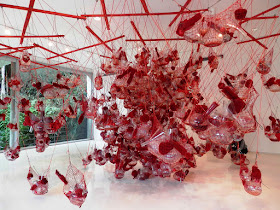"Brazilian artist Tunga, born Jose de Barros Carvalho e Mello, was a talented and eclectic creator who worked in sculpture, installation, photography, poetry, and video. His large-scale installations and sculptures were always capable of transforming galleries and museums into dreamlike environments thanks to the most versatile materials such as plastic, thread, and recycled objects. Even though his process was materially intensive, Tunga’s practice was also clearly conceptual. His works are intellectually puzzling, they resist certainty and confuse the audience. For instance, in his piece from 2007 entitled At the Light of Both Worlds from 2007, Tunga hung from a gallery ceiling a massive assemblage of bones and bronze replicas of classical art – this outstanding work is a unique commentary on the intrinsic balance between life and death.
Born in Palmares, Pernambuco in 1952, Tunga moved to Rio de Janeiro, where he completed the course of architecture and urbanism at the University of Santa Ursula. Thanks to his father, writer Gerardo de Mello Mourão, Tunga knew Brazilian modernism very early. He began his career in the early 1970s. At the time, he made prevalently drawings and sculptures. His figurative images revolve around daring and controversial themes, such as in the famous series entitled Children’s Masturbation Museum, from 1974. He collaborated with the magazine Malasartes and he was also in contact with the newspaper A Parte do Fogo in the 1980s. He worked as a lecturer at the Philosophy Institute of the Federal University of Rio de Janeiro and at the Faculty of Architecture and Urbanism of the University of Santa Ursula. Tunga won one of his most important awards already in the mid 80s – he was awarded the State Government Prize for an exhibition held at the Rio Grande do Sul Art Museum in 1986. The following year, he engaged in videography and performed the video Nervo de Prata, made in partnership with Arthur Omar. In 1990, he received the Brasília Prize for Plastic Arts and, in 1991, the Mário Pedrosa Prize of the Brazilian Association of Art Critics (ABCA) for the work Preliminaries of the Incest Palindrome. In order to carry out his work, Tunga investigated various areas of knowledge such as literature, philosophy, psychoanalysis, theater, as well as the topics of natural and biological sciences."(widewalls.ch)
Born in Palmares, Pernambuco in 1952, Tunga moved to Rio de Janeiro, where he completed the course of architecture and urbanism at the University of Santa Ursula. Thanks to his father, writer Gerardo de Mello Mourão, Tunga knew Brazilian modernism very early. He began his career in the early 1970s. At the time, he made prevalently drawings and sculptures. His figurative images revolve around daring and controversial themes, such as in the famous series entitled Children’s Masturbation Museum, from 1974. He collaborated with the magazine Malasartes and he was also in contact with the newspaper A Parte do Fogo in the 1980s. He worked as a lecturer at the Philosophy Institute of the Federal University of Rio de Janeiro and at the Faculty of Architecture and Urbanism of the University of Santa Ursula. Tunga won one of his most important awards already in the mid 80s – he was awarded the State Government Prize for an exhibition held at the Rio Grande do Sul Art Museum in 1986. The following year, he engaged in videography and performed the video Nervo de Prata, made in partnership with Arthur Omar. In 1990, he received the Brasília Prize for Plastic Arts and, in 1991, the Mário Pedrosa Prize of the Brazilian Association of Art Critics (ABCA) for the work Preliminaries of the Incest Palindrome. In order to carry out his work, Tunga investigated various areas of knowledge such as literature, philosophy, psychoanalysis, theater, as well as the topics of natural and biological sciences."(widewalls.ch)















No comments:
Post a Comment